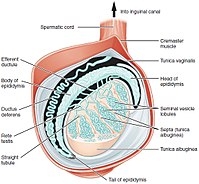
Photo from wikipedia
ABSTRACT Objective: To assess the effectiveness of utilising N-acetyl cysteine (NAC) to treat tissue damage brought on by undescended testis (UT) in rats after orchiopexy. STUDY DESIGN Experimental study. Place… Click to show full abstract
ABSTRACT Objective: To assess the effectiveness of utilising N-acetyl cysteine (NAC) to treat tissue damage brought on by undescended testis (UT) in rats after orchiopexy. STUDY DESIGN Experimental study. Place and Duration of the Study: Bolu Abant İzzet Baysal University, Bolu, Turkey, from January 2018 to June 2020. METHODOLOGY The UT model was created by administering flutamide to pregnant rats. Four groups of animals were created as the control group (offsprings of pregnant rats without flutamide), group II (UT), group III (UT + orchiopexy), and group IV (UT + orchiopexy + NAC); each containing eight animals. RESULTS Group IV had a higher level of glutathione peroxidase than groups III and II (p=0.001 and p=0.002, respectively). Malondialdehyde was reduced in group IV compared with groups III and II (both p<0.001). There were differences in mean apoptotic cell counts (ACC) among the groups (p<0.001). ACC in group IV was lower than in group III (p<0.001). Sperm counts were higher in group IV than ın groups III and II, and in group III they were higher than group II (p<0.001 all) and similar between groups IV and control group (p=0.102). CONCLUSION Orchiopexy reduced UT-related testicular damage, additionally using NAC following orchiopexy may further reduce testicular damage through its antioxidant effects. KEY WORDS Undescended testis, Testis damage, Orchiopexy, N-acetyl cysteine, Antioxidant.
Journal Title: Journal of the College of Physicians and Surgeons--Pakistan : JCPSP
Year Published: 2023
Link to full text (if available)
Share on Social Media: Sign Up to like & get
recommendations!